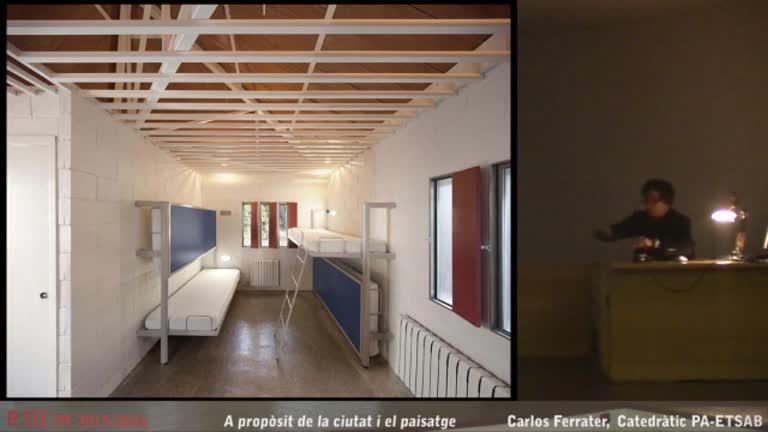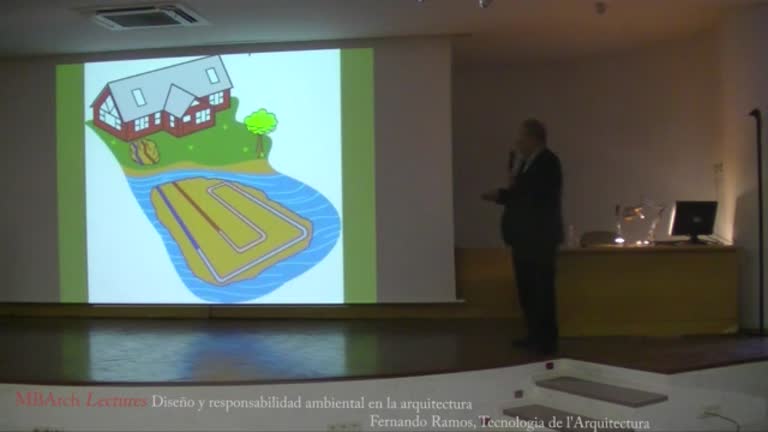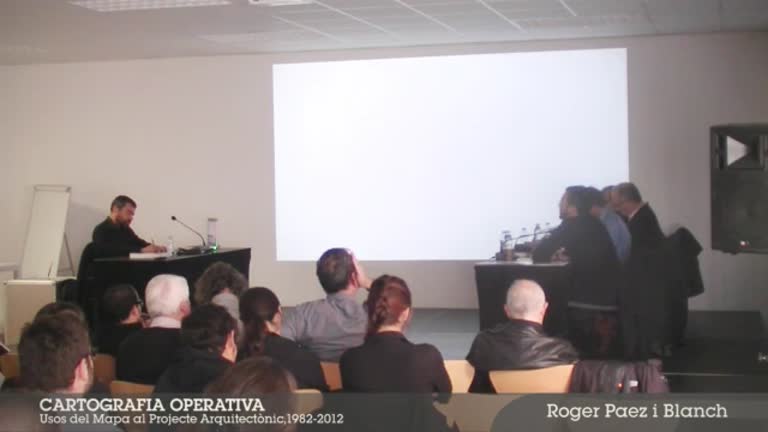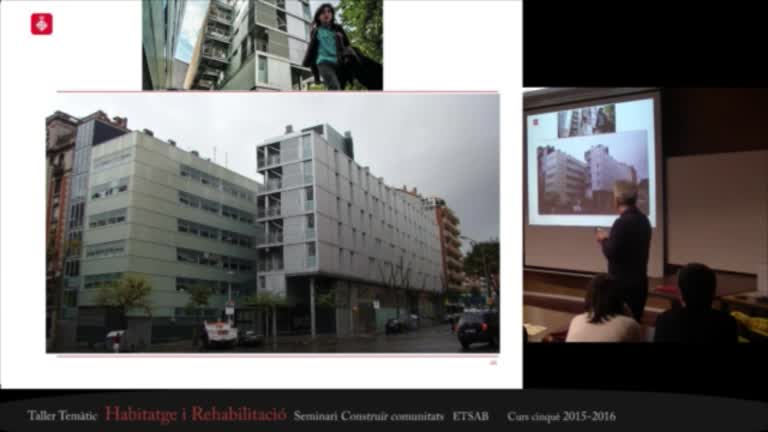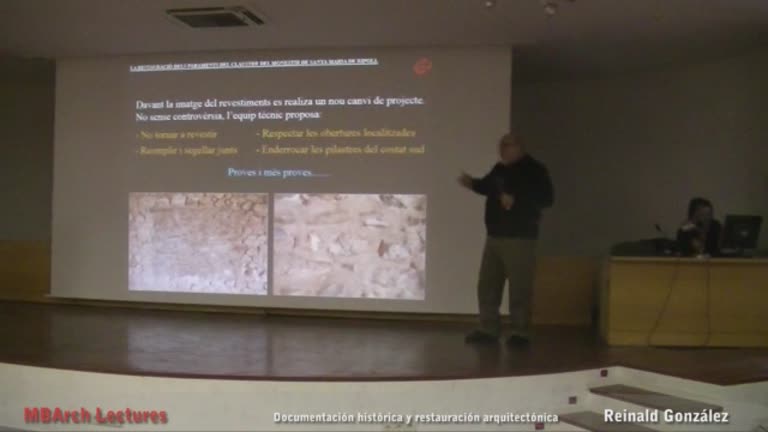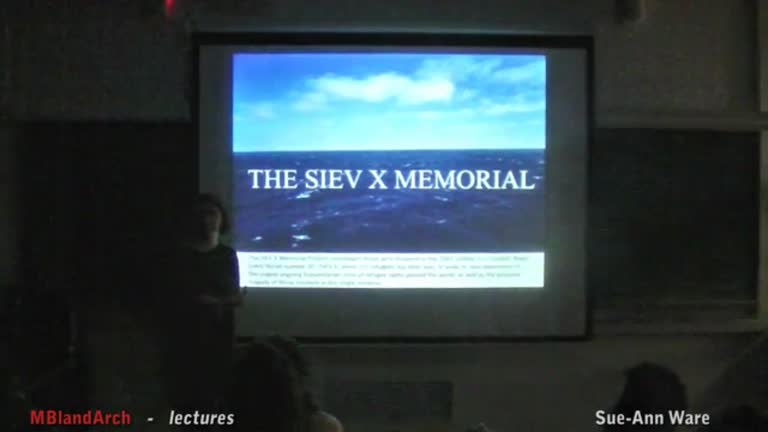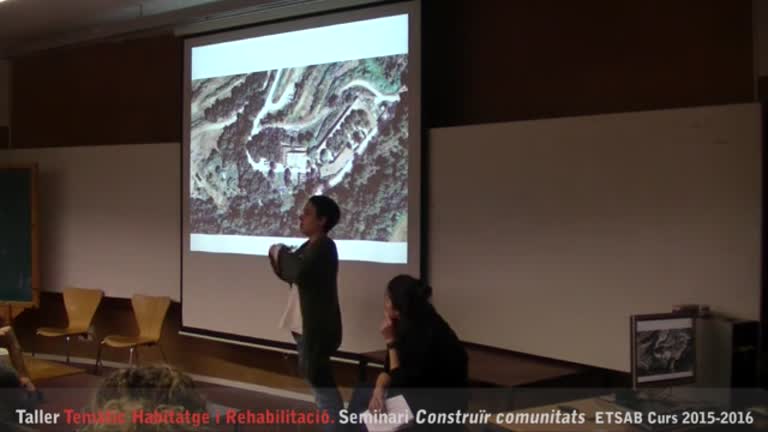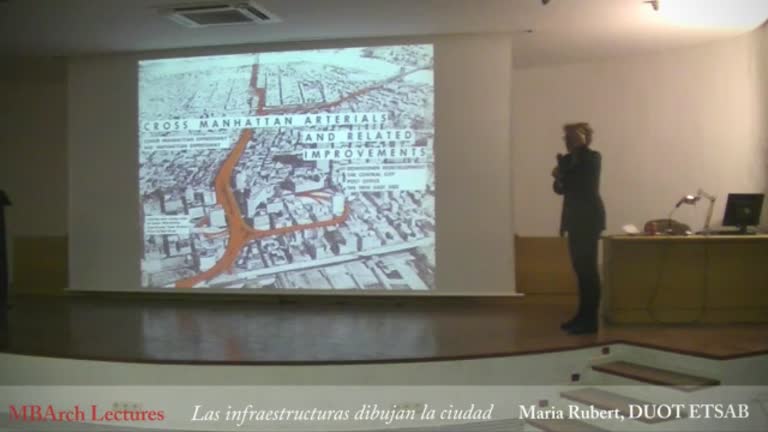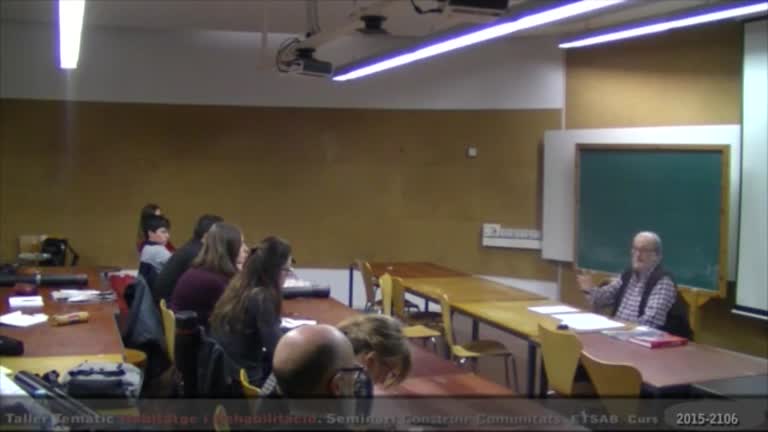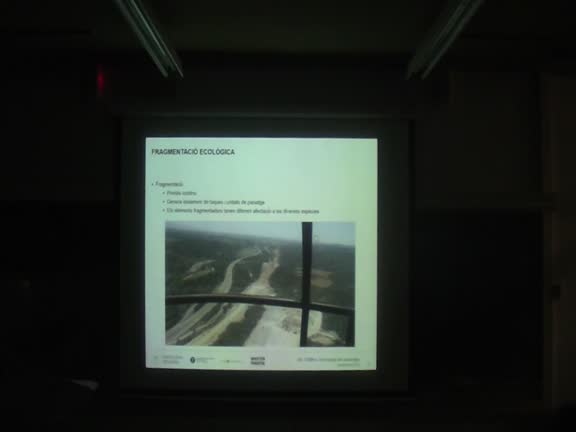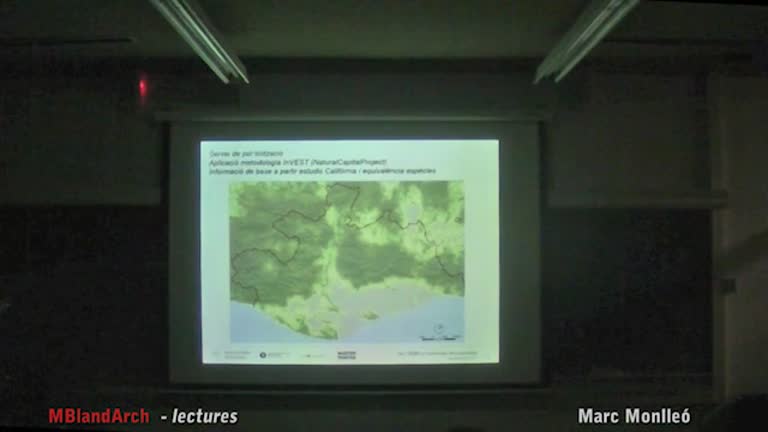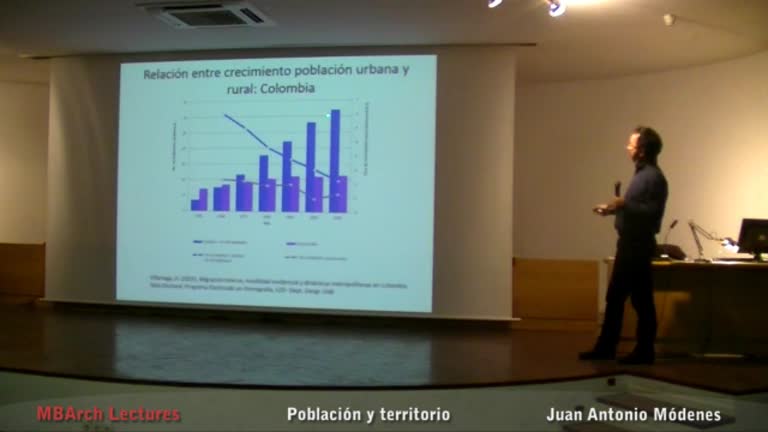Objectes multimèdia amb l’etiqueta: Escola Tècnica Superior d'Arquitectura de Barcelona
Resultats de la cerca
A propòsit de la ciutat i el paisatge
Accés obert
30 de nov. 2015
Conferència de Carlos Ferrater, Catedràtic de Projectes Arquitectònics ETSAB per l'assignatura Projectes III [m] coordinat i presentat per Alberto Peñín.
Diseño y responsabilidad ambiental en la Arquitectura
Accés obert
27 de nov. 2015
Conferència de Fernando Ramos, Departament de Tecnologia de l'Arquitectura. Presentació d'Enrique Granell, Teoria i Hª de l'Arquitectura ETSAB
Cartografia operativa. Usos del Mapa al Projecte Arquitectònic, 1982-2012
Accés obert
26 de nov. 2015
Tesi Doctoral de Roger Paez i Blanch. Director: Iñaki Ábalos (ETSAM-UPM / Harvard GSD). Co-director: Jaime Coll (ETSAB-UPC). Departament de Projectes Arquitectònics. Escola Tècnica Superior d'Arquitectura de Barcelona, Universitat Politècnica de Catalunya.
Tesi Doctoral dipositada a TDX: http://www.tdx.cat/handle/10803/327026
We live in a complex world. For some time, the great certainties and the narratives they support have been shown to be inadequate as an entryway into the richness of the contemporary world. lt is not just a question of understanding the world around us, but also of developing the conceptual frameworks and the tools to help us transform it. Spatial design practices, with architecture at the head, play a fundamental role in this question, because they are active agents in both interpreting and shaping the reality we live in. Based on that interest, this dissertation explores the critical uses of maps in architectural design, and it posits the concept of operative cartography as the backbone to structure the work. In its most immediate definition, operative cartography is the production and use of maps to broaden our conception of reality and to promote its transformation. The concept is founded on understanding maps as design tools: they don't just inform; they primarily propose. Maps construct reality in a particular way. As such, cartography is a propositional discipline, not a merely descriptive one. The potentially operative nature of maps in architectural design is clear. The specific constructions of reality inherent in maps not only open up new conceptions of the reality being mapped; they also present new possibilities for a real transformation of the milieu. In this sense, mapping and maps are put forward as tools with an enormous power to affect the design processes that are used to transform our environment. This dissertation studies the difieren!t kinds of operative relationships between maps and architectural design, and it outlines avenues for an in-depth exploration of this relationship. The first part is the most speculative: it introduces and develops the concept of operative cartography as an agent with the ability to expand on the objectives , methods and tooIs of contemporary architectural design. The second, more expository part shows that the map is a rich and complex document, which has been claimed culturally from contrasting positions . Part three, evocative in tone, makes it clear that maps are an endless source of interpretative richness that reach far beyond the dominant, scientific and positivist, vision of cartography. Finally, part four is the most demonstrative. First, it proposes a taxonomy of the areas and modes of cartographic operativity in architectural design during the period 1982-2012; then the validity and utility of that taxonomy is tested through the study of 24 recent designs. The case studies begin with a projective survey of the conditions of the milieu subject to intervention. From difierent architectural sensitivities, they all work pragmatically and critically, acknowledging the need for an effective transformation of the milieu based on an understanding of pre-existing conditions, without being subject, however, to the tyranny of what already is . Based on the concept and practices of operative cartography, we can build bridges to create a dialog between what exists and what doesn't exist yet: in other words, design. This encourages an active and innovative architecture based on the effective and symbolic expansion of the milieu. The main aim of this dissertation is to offer a methodological contribution to architectural design, both in conceptual and instrumental terms. The dissertation takes a pragmatist angle, which aims not only to discuss the present but, above all, to generate a toolbox to help expand on the objectives, methodologies and formats of architectural design in the immediate future.
Vivim en un món complex. Ja fa temps que les grans certeses i les narracions que aquestes suporten s'han demostrat inadequades per accedir a la riquesa del món contemporani. No es tracta només de saber entendre el nostre entorn sinó, en igual mesura, de desenvolupar els marcs conceptuals i les eines que ens permetin transformar-lo. Les disciplines del projecte espacial, amb l'arquitectura al capdavant, juguen un paper fonamental en aquesta qüestió, ja que són agents actius tant en la interpretació com en la configuració de la realitat en la qual vivim. Partint d'aquest interès, la tesi doctoral explora els usos crítics de la cartografia en l'àmbit del projecte arquitectònic, i proposa el concepte de cartografia operativa com a espina dorsal per ordenar el treball. En la seva definició més inmediata possible, la cartografia operativa és la producció i utilització de mapes per ampliar la nostra concepció de la realitat i promoure'n la transformació. Aquest concepte parteix d'entendre la cartografia com una eina projectiva: els mapes no només informen sinó que sobretot proposen. La cartografia construeix la realitat de manera concreta i és, per tant, una disciplina propositiva i no pas simplement descriptiva. El caràcter potencialment operatiu de la cartografia en el marc del projecte arquitectònic és clar. A partir de les construccions concretes de la realitat efectuades pel mapa, s'obren no només noves concepcions de la realitat cartografiada sinó també noves possibilitats per a transformar-la. Així doncs, la pràctica cartogràfica i el mapa com a document són eines amb un enorme poder per afectar els processos de projecte a través dels quals es transforma l'entorn dels homes. La tesi estudia les diferents maneres a través de les quals s'estableixen relacions operatives entre la cartografía i el projecte arquitectònic, i delinea camins per explorar en profunditat aquesta relació. La primera part és la més especulativa: proposa i desenvolupa el concepte de cartografia operativa com un agent amb capacitat d'ampliar els objectius, mètodes i eines del projecte arquitectònic contemporani. La segona part, de caràcter expositiu, mostra que el mapa és un document ric i complex que ha estat incardinat culturalment des de posicions molt diferenciades. La tercera part, de to evocatiu, palesa que els mapes són una font inesgotable de riquesa interpretativa que van molt més enllà del que pretén la visió dominant de la cartografia, d'arrel científica i positivista. La quarta i última part és la més demostrativa. En primer lloc proposa una taxonomia dels modes d'operativitat cartogràfica en el projecte arquitectònic en el període 1982-2012, i després comprova la seva validesa i utilitat a través de l'estudi de vint-i-quatre projectes recents. Els projectes estudiats parteixen d'un reconeixement projectiu de les condicions de l'entorn on es treballa. Des de sensibilitats arquitectòniques molt diverses, tots ells treballen simultàniament des del pragmatisme i la crítica, assumint la necessitat d'intervenir efectivament en la transformació de l'entorn a partir d'una comprensió d'allò existent, sense per això estar sotmès a la tirania del que (ja) és. A través del concepte i les pràctiques de cartografia operativa es poden construir ponts de diàleg entre allò existent i allò que encara no existeix, és a dir, el projecte. D'aquesta manera es fomenta una arquitectura inquieta i innovadora basada en l'ampliació tan efectiva com simbòlica de l'entorn. L'objectiu principal d'aquesta tesi és aportar una contribució metodològica, tant conceptual com instrumental, als projectes arquitectònics. La tesi adopta una angulació pragmatista, que busca no només explicar el present sinó sobretot generar una caixa d'eines que permeti ampliar els objectius, les metodologies i els formats del projecte arquitectònic en el futur immediat. [-]
Tesi Doctoral dipositada a TDX: http://www.tdx.cat/handle/10803/327026
We live in a complex world. For some time, the great certainties and the narratives they support have been shown to be inadequate as an entryway into the richness of the contemporary world. lt is not just a question of understanding the world around us, but also of developing the conceptual frameworks and the tools to help us transform it. Spatial design practices, with architecture at the head, play a fundamental role in this question, because they are active agents in both interpreting and shaping the reality we live in. Based on that interest, this dissertation explores the critical uses of maps in architectural design, and it posits the concept of operative cartography as the backbone to structure the work. In its most immediate definition, operative cartography is the production and use of maps to broaden our conception of reality and to promote its transformation. The concept is founded on understanding maps as design tools: they don't just inform; they primarily propose. Maps construct reality in a particular way. As such, cartography is a propositional discipline, not a merely descriptive one. The potentially operative nature of maps in architectural design is clear. The specific constructions of reality inherent in maps not only open up new conceptions of the reality being mapped; they also present new possibilities for a real transformation of the milieu. In this sense, mapping and maps are put forward as tools with an enormous power to affect the design processes that are used to transform our environment. This dissertation studies the difieren!t kinds of operative relationships between maps and architectural design, and it outlines avenues for an in-depth exploration of this relationship. The first part is the most speculative: it introduces and develops the concept of operative cartography as an agent with the ability to expand on the objectives , methods and tooIs of contemporary architectural design. The second, more expository part shows that the map is a rich and complex document, which has been claimed culturally from contrasting positions . Part three, evocative in tone, makes it clear that maps are an endless source of interpretative richness that reach far beyond the dominant, scientific and positivist, vision of cartography. Finally, part four is the most demonstrative. First, it proposes a taxonomy of the areas and modes of cartographic operativity in architectural design during the period 1982-2012; then the validity and utility of that taxonomy is tested through the study of 24 recent designs. The case studies begin with a projective survey of the conditions of the milieu subject to intervention. From difierent architectural sensitivities, they all work pragmatically and critically, acknowledging the need for an effective transformation of the milieu based on an understanding of pre-existing conditions, without being subject, however, to the tyranny of what already is . Based on the concept and practices of operative cartography, we can build bridges to create a dialog between what exists and what doesn't exist yet: in other words, design. This encourages an active and innovative architecture based on the effective and symbolic expansion of the milieu. The main aim of this dissertation is to offer a methodological contribution to architectural design, both in conceptual and instrumental terms. The dissertation takes a pragmatist angle, which aims not only to discuss the present but, above all, to generate a toolbox to help expand on the objectives, methodologies and formats of architectural design in the immediate future.
Vivim en un món complex. Ja fa temps que les grans certeses i les narracions que aquestes suporten s'han demostrat inadequades per accedir a la riquesa del món contemporani. No es tracta només de saber entendre el nostre entorn sinó, en igual mesura, de desenvolupar els marcs conceptuals i les eines que ens permetin transformar-lo. Les disciplines del projecte espacial, amb l'arquitectura al capdavant, juguen un paper fonamental en aquesta qüestió, ja que són agents actius tant en la interpretació com en la configuració de la realitat en la qual vivim. Partint d'aquest interès, la tesi doctoral explora els usos crítics de la cartografia en l'àmbit del projecte arquitectònic, i proposa el concepte de cartografia operativa com a espina dorsal per ordenar el treball. En la seva definició més inmediata possible, la cartografia operativa és la producció i utilització de mapes per ampliar la nostra concepció de la realitat i promoure'n la transformació. Aquest concepte parteix d'entendre la cartografia com una eina projectiva: els mapes no només informen sinó que sobretot proposen. La cartografia construeix la realitat de manera concreta i és, per tant, una disciplina propositiva i no pas simplement descriptiva. El caràcter potencialment operatiu de la cartografia en el marc del projecte arquitectònic és clar. A partir de les construccions concretes de la realitat efectuades pel mapa, s'obren no només noves concepcions de la realitat cartografiada sinó també noves possibilitats per a transformar-la. Així doncs, la pràctica cartogràfica i el mapa com a document són eines amb un enorme poder per afectar els processos de projecte a través dels quals es transforma l'entorn dels homes. La tesi estudia les diferents maneres a través de les quals s'estableixen relacions operatives entre la cartografía i el projecte arquitectònic, i delinea camins per explorar en profunditat aquesta relació. La primera part és la més especulativa: proposa i desenvolupa el concepte de cartografia operativa com un agent amb capacitat d'ampliar els objectius, mètodes i eines del projecte arquitectònic contemporani. La segona part, de caràcter expositiu, mostra que el mapa és un document ric i complex que ha estat incardinat culturalment des de posicions molt diferenciades. La tercera part, de to evocatiu, palesa que els mapes són una font inesgotable de riquesa interpretativa que van molt més enllà del que pretén la visió dominant de la cartografia, d'arrel científica i positivista. La quarta i última part és la més demostrativa. En primer lloc proposa una taxonomia dels modes d'operativitat cartogràfica en el projecte arquitectònic en el període 1982-2012, i després comprova la seva validesa i utilitat a través de l'estudi de vint-i-quatre projectes recents. Els projectes estudiats parteixen d'un reconeixement projectiu de les condicions de l'entorn on es treballa. Des de sensibilitats arquitectòniques molt diverses, tots ells treballen simultàniament des del pragmatisme i la crítica, assumint la necessitat d'intervenir efectivament en la transformació de l'entorn a partir d'una comprensió d'allò existent, sense per això estar sotmès a la tirania del que (ja) és. A través del concepte i les pràctiques de cartografia operativa es poden construir ponts de diàleg entre allò existent i allò que encara no existeix, és a dir, el projecte. D'aquesta manera es fomenta una arquitectura inquieta i innovadora basada en l'ampliació tan efectiva com simbòlica de l'entorn. L'objectiu principal d'aquesta tesi és aportar una contribució metodològica, tant conceptual com instrumental, als projectes arquitectònics. La tesi adopta una angulació pragmatista, que busca no només explicar el present sinó sobretot generar una caixa d'eines que permeti ampliar els objectius, les metodologies i els formats del projecte arquitectònic en el futur immediat. [-]
Cap a un Pla d'Habitatge
Accés obert
26 de nov. 2015
Conferència de Josep Mª Montaner, Arquitecte per l'ETSAB i Regidor d'Habitatge del Districte de Sant Martí de l'Ajuntament de Barcelona. Presenta la sessió Antoni Ramón, Director del Departament de Teoria i Hª de l'Arquitectura ETSAB.
Documentación histórica y restauración arquitectónica
Accés obert
25 de nov. 2015
Conferència de Reinald González de Veclus, Doctor en Història de l'Art, membre del Grup de Recerca "Institut de Recerca Històrica" (UdG). Presentació a càrrec d'Enric Granell, Dep. Composició ETSAB.
Searching for Sustainability, finding her and taking a walk in Australia
Accés obert
24 de nov. 2015
Conferència de Sue-Ann Ware, Dean of Academic School of Architecture, Planning and Landscape Newcastle University pel cicle MBLandArch
10. Habitatge cooperatiu i cooperatives d'arquitectes
Accés obert
24 de nov. 2015
Conferència a càrrec de Mª Josep Lázaro (Col·lectiu Celobert ) i Cristina Gamboa (LaCol Arquitectura). Presenta la sessió Antoni Ramón, Departament de Teoria i Història de l'Arquitectura ETSAB
Las infraestructuras dibujan la ciudad
Accés obert
23 de nov. 2015
Conferència de Maria Rubert, DUOT ETSAB pel cicle MBArch. Presenta la sessió Enrique Granell, CA ETSAB.
Habitatge social a Barcelona, 1979-2015
Accés obert
19 de nov. 2015
Conferència a càrrec de lo'Arquitecte Xavier Valls. Presenta la sessió Antoni Ramón, Professor i Director del Departament de Teoria i Historia de l'Arquitectura ETSAB - UPC.
Del ADN a la Ecologia del Paisatge
Accés obert
17 de nov. 2015
Conferència del Biòleg Marc Montlleó pel programa de Postgrau MBLandArch. Presentat per Pepa Moràn, Arquitecta i Paisatgista, i Enric Batlle, Director del MBlandArch.
Población y territorio. Arquitectura, Ciudad y Proyecto
Accés obert
13 de nov. 2015
Conferència de Juan Antonio Módenes, Geògraf (UAB), Investigador del Centre d'Estudis Demogràfics. Presentació d'Enric Granell, Departament de Teoria, Hª de l'Arquitectura ETSAB.


